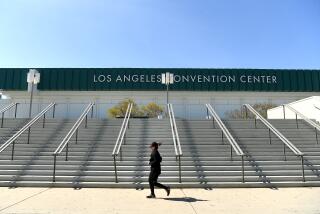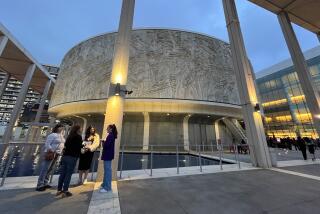Arts Center’s Budget Growth to Allow More Programming : Finances: Thanks to a series of summer sellouts, the facility is $400,000 ahead of its projected spending plan, meaning the board of directors can add some shows in 1990.
COSTA MESA — Confident of ending the year in the black after a series of sold-out summer programs, the Orange County Performing Arts Center has adopted an operating budget of $16.5 million for 1990--$1.5 million larger than this year’s. The money would support a slight increase in programming, according to Center President Thomas R. Kendrick.
Meanwhile, the Center has asked its original architect, theater designer and general contractor to prepare a “specific needs study” for an proposed new concert hall, said Kendrick, who made the announcements Thursday after a quarterly meeting of the Center’s board of directors.
The Center is $400,000 ahead of its current projected $15-million budget because of its “extraordinarily successful summer,” Kendrick said. “We had 25 sellouts in a row within four weeks of (performances by) the Kirov Ballet, ‘Fiddler on the Roof’ and ‘Cats.’ ”
The 1990 budget increase is attributable principally to plans for “slightly more programming.”
Last year, there were 210 presentations in the building, sponsored by regional groups and by the Center itself. Revenue, generated mostly through ticket sales, are projected to increase by $1.5 million in 1990, Kendrick said. The prediction is based on increased attendance, he added, not higher ticket prices.
Overall attendance so far this year is up 5% and subscription renewals for both the Center’s ballet and Broadway series--which alone gained 1,300 new subscribers this year--have been strong, Kendrick said.
Ticket sales have been far above the national average since the Center opened in 1986, Kendrick continued. Last year, box office receipts contributed 83% of earned revenue, compared to the national average of about 65%.
Even with the ticket sales, the Center expects a budget deficit of $5.73 million before charitable donations for the 1990 budget, Kendrick said. But fund-raising efforts and other sources of support are expected to deliver $5.74 million.
Included in the 1990 budget is $100,000 for the needs study, to be conducted by CRSS (called Caudill Rowlett Scott when the firm designed the center), Peck-Jones General Contractors, and John von Szeliski, who designed technical elements of the Center’s interior.
The study is intended to help staff members determine “exactly what kind of (new) structure would be built,” Kendrick said. Size and overall purpose would be addressed, along with questions regarding specific facilities. Construction costs can then be estimated and final plans drawn, Kendrick said.
Henry T. Segerstrom, the Center’s chairman and chief operating officer, said a site for the proposed Orange County hall also would not be discussed until the needs study is complete. Segerstrom’s family donated the land on which the current Center building sits.
An earlier marketing feasibility study called for a new concert hall and a smaller theater within the next decade. The proposed hall, to be used chiefly by the Pacific Symphony and the Orange County Philharmonic Society, could cost from $60 million to $80 million and seat 2,300 to 2,500, the study estimates.
Center officials expect the new study to “refine” these estimates. They also hope it will avert problems in evidence at Los Angeles’ Walt Disney Concert Hall, now under construction. Projected costs for that hall (for which Peck-Jones also is contractor) have risen dramatically above initial projections, Segerstrom said.
The Center board on Thursday also nominated two new members for three-year terms: Reed L. Royalty, Pacific Bell’s vice president for Orange, Riverside, San Bernardino and Inyo counties; and Michael B.A. Nobbs, vice president and managing director of Citicorp Real Estate Western Region.
The Center also signed a new three-year contract with the International Alliance of Theatrical Stage Employees, the stagehands’ union, which remains virtually unchanged in its primary terms, Kendrick said.
More to Read
The biggest entertainment stories
Get our big stories about Hollywood, film, television, music, arts, culture and more right in your inbox as soon as they publish.
You may occasionally receive promotional content from the Los Angeles Times.










